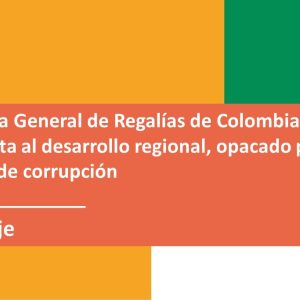By: Jorge Calle Ríos. Proantioquia
Citizen participation as a crucial element in the processes of territorial development associated with the mining-energy sector, presents a singularity given the political and social situation that has arisen from the community approval of projects of this nature: popular consultations have positioned themselves as the exclusive mechanism to determine, within a local community, the validity, relevance and opportunity of mining-energy projects within the framework of processes of endogenous economic growth and territorial social progress.
However, citizen and community participation finds greater support in territorial planning processes in terms of spatial planning and local development. In this sense, recognizing and recovering the mechanisms available in the planning instruments in terms of community involvement in development processes are transversal to the achievement of agreements, citizen participation in the design, formulation and implementation of extractive projects and the generation and strengthening of the value of co-responsibility in the success and appropriation of these projects within the framework of governance reflected in the relationship between community, company and State.
Therefore, to recognize and understand the multisectoral nature of community participation, beyond the valid exercise of popular consultation, is to generate strategic value in the registration of community and institutional strengthening processes from local, regional and national planning instruments, in a framework of local capacity building and definition of communication and processing vehicles in the face of elements of public and national interest.
Thus, with regard to mining and energy processes, it is essential to determine the differences that arise from the promotion of participation in each of the sectoral activities. Although there is a common regulatory umbrella that accounts for the instruments of planning and local territorial management, local development and citizen participation, the monitoring and control instances, as well as the strategies anchored to sectoral particularities, find differential critical routes in the relationship with the community, not only due to the organizational nature, but also due to the social, economic and environmental impacts that each sector awakens. The latter also needs to be analyzed in terms of institutional supply and demand(inputs – outputs) that determine the field of business compensation in the areas already mentioned and in the most appropriate and pertinent relationship mechanisms, determined by the scope, benefits, times, territories and impacts of the projects.
The need for articulation between local, regional and national governments is crucial not only in terms of relations and deliberation caused by the decentralization structure, but also in the thematic coordination and coordination of actions included in the development plans of each of the territorial instances. In other words, in order to recognize and promote goods and services of national public utility, it is essential that development planning instruments be in line with the same practical and discursive approach. This generates a radial effect in the following directions:
o Generates institutional and legal security for the investment of the business sector in territories with extractive potential, after a technical analysis by the UPME and the competent environmental authorities regarding the scale and scope of the project.
o Allows the structuring of exploration and exploitation business plans to be coordinated with development guidelines determined within a framework of multilevel governance between the different territorial government agencies. In other words, the path of development is followed in a planned and concerted manner, reducing the space for speculation and dispersion.
o The channels of citizen and community participation find the same line of development and deployment. Likewise, this mechanism is strengthened through the public management capacity extended to the different levels of government, prioritizing socially problematic situations and determining joint actions for solutions and networking.
o Strengthens the installed institutional capacities in local terms, consolidating the decentralization process, without this being a struggle between levels of government and, on the contrary, promoting the principles of cooperation, coordination and subsidiarity in favor of citizen participation as a virtuous factor of local development.
However, in the face of decision-making processes based on objective information, it is necessary that the characterization of ecosystem assets that take place in the framework of extractive projects be analyzed in the light of phases prior to exploitation, in order to have data and information that enable a constructive discussion between the community, company and State framed in the natural resource economy. This, in turn, makes it possible to generate work routes within productive linkage initiatives such as payment for environmental services, as a mechanism for the economic activation of communities and the preservation of these environmental supports, with their own or third party management arms.
Likewise, although it is recognized that the processes of social management in extractive activities do not arise from a unified formula, it is necessary to create a Mining-Energy Dialogue Table in which institutional arrangements for critical public policy issues can be agreed upon in a multisectoral environment. It also serves as a scenario for the transfer of successful experiences and good practices of business behavior in environments of social conflict, as well as methodologies for community relations based on participatory diagnoses and collective action.
These recommendations, expressed in terms of public policy, are relevant not only because of the current context of popular consultations, but also because of structural issues that should be considered within the framework of clear rules of the game in terms of community participation, as an instance of collective construction of territorial development visions. In short, the coordination and coherence of territorial and development planning with the different instruments and mechanisms for participation that are available in land use plans and municipal and regional development plans, are scenarios for dialogue and public policy advocacy in the medium and long term, with citizen and community participation in the determining stages of extractive projects, even when they are in the exploration phase. Early agreements between civil society, business and the State generate relationships, co-responsibility and social fabric: key assets for territorial development projects.


